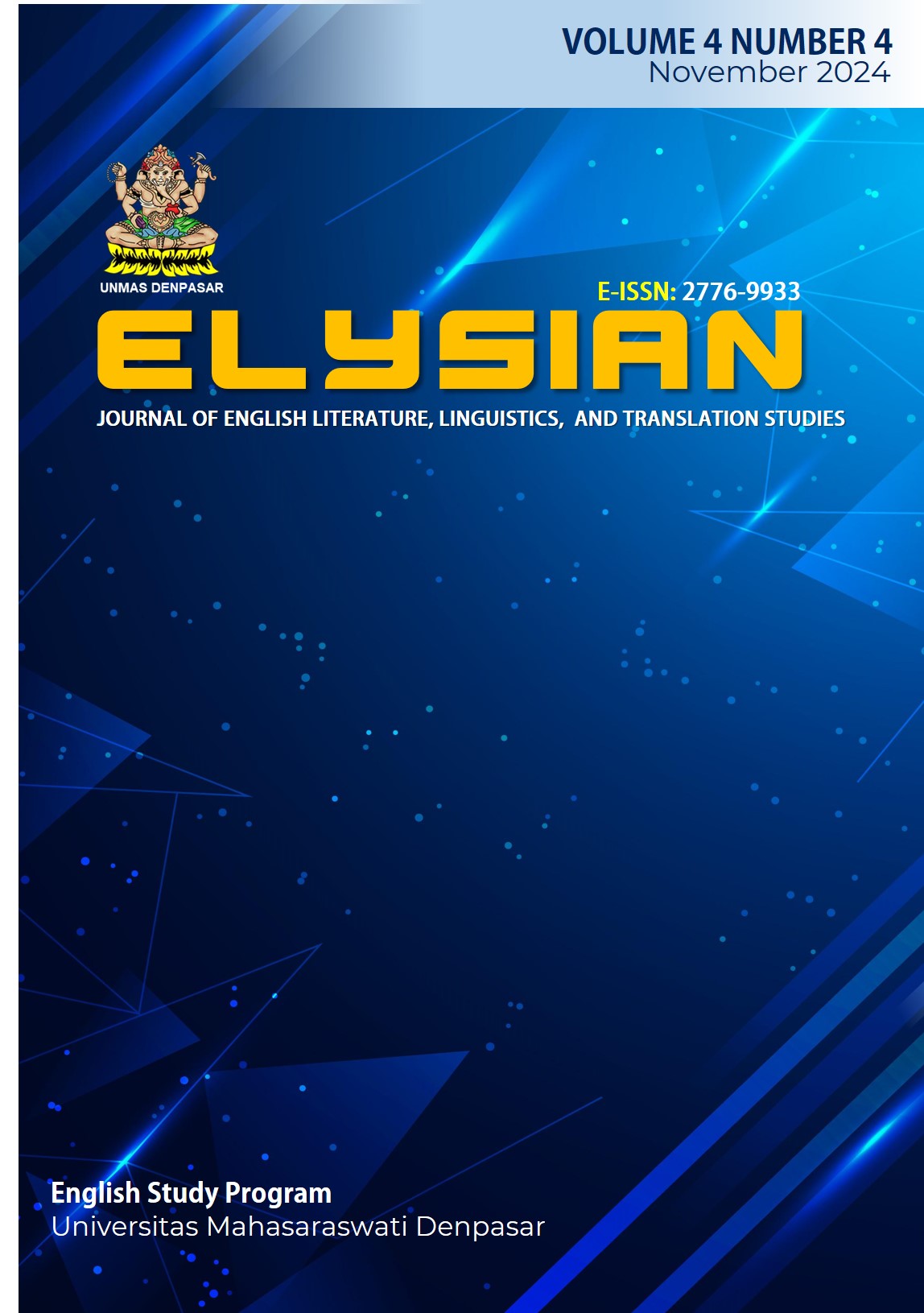Derivational Suffixes in the Reading Textbook of Sixth Grade Elementary School by Evan Moor
DOI:
https://doi.org/10.36733/elysian.v4i4.9752Keywords:
derivational, suffixes, textbookAbstract
This study focuses on derivational suffixes that are found in textbook "Sixth Grade Elementary School" by Evan Moor. This project aims to discover the types and process of derivational suffixes in the data source, the data was collected using an observation method, and it was analyzed using a descriptive qualitative approach. The data used in this research were analyzed using theory from Plag (2003) and McCarthy (2002). The study identified four main types of derivational suffixes: nominal, verbal, adjectival, and adverbial suffixes. A total of 98 data derivational suffixes were identified. The research revealed that nominal suffixes were the most common at 58 data of suffixes included -er, -ing, -ment, -ion, -ance, -ence, and -ness. Followed by adjectival suffixes accounted 22 data, comprise suffixes like -ly, -al, -able/-ible, -ful, -ous, -less, -ive, and -ish. Adverbial suffixes with 15 instances characterized by the suffix -ly. Verbal suffixes was the least frequently found in the data analysis at 3 represented by -ize. Based on the finding indicate that derivational suffixes as the most dominant, it is relevant with the theory which is explain that the number of nominal suffixes were frequently than other suffixes. The process of derivational suffixes which is described with flat structure it really help to decide the changing of word class process happen in the data.
References
Cahyani, N. L. D. 2022. Derivational affixes found in the caption of selected post of @bawabali_official account on Instagram. Thesis. Denpasar. English Study Program Faculty of Foreign Language Mahasaraswati University.
Carstairs-McCarthy, A. 2002. An introduction to english morphology words and their structure. Edinburgh: Edinburgh University Press Ltd.
Chriswitrilya, N. L. P. 2020. A morphological analysis of suffixes found in Siddhartha novel by Hermann Hesse. Thesis. Denpasar. English Study Program Faculty of Foreign Language Mahasaraswati University.
Dwiyanti, N.K.C., Maharani, P.D, & Winarta, I. B.G.N. 2022. Types of derivational affixes in new idea magazine: a morphological analysis. Journal of Language and Applied Linguistics. Vol. 3 No. 1, 143-153.
Katamba, Francis. 1993. Modern Linguistic Morphology. England: Macmillan Press
Ningsih, N. M. C. W., & Utami, N. P. C. P. (2024). Derivational Suffixes in the Return of Sherlock Holmes Novel: A Morphological Analysis. Kulturistik: Jurnal Bahasa dan Budaya, 8(1).
Oktariyani, N. 2022. An analysis of derivational suffixes found in english textbook of tenth grade at SMA negeri 1 Rengat Barat entitled pathway to english.Thesis. Pekanbaru: Faculty of Teacher Training and Education,University of Islam Riau University.
Oxford University Press. 2024. Definitions, Meanings, Synonyms and Grammar by Oxford Dictionary. Accessed on 2024, July 19.
Plag, I. 2003. Word formation in english. The Edinburgh Building: Cambridge University Press.
Putra, A. R., & Pradana, A. (2024). A Descriptive Study of English Morphemes in terms of Inflectional and Derivational Suffixes in Journal Articles of JDER 2023. Edu-Ling: Journal of English Education and Linguistics, 7(2), 245-255.Putri, S. H., et al. 2021. An analysis of derivational suffixes found in reading texts of english textbook. Journal Kreatif Online (JKO). Vol.9. No.2, 72-83








